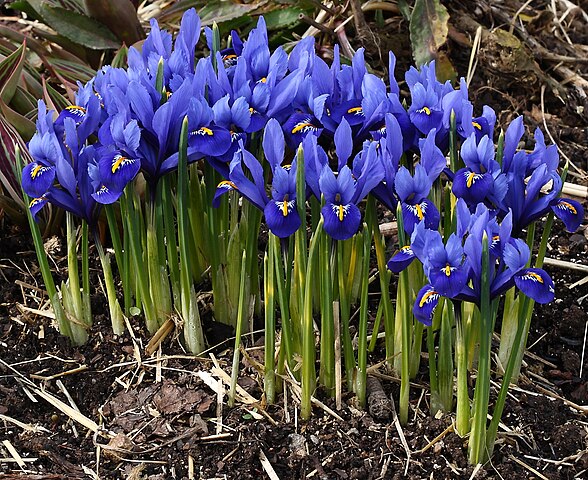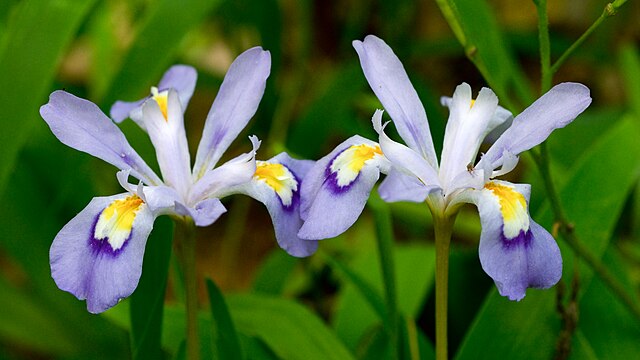Chapter 60 Choosing and Styling Accent Plants
At every bonsai exhibit there are small containers of herbaceous plants interspersed between the stars of the show. “Keiko” and “kusamono” are two names for the art of selecting and placing these accent plants. Keiko also is the name of a formal philosophical school that codified many of the rules of tokonoma arrangement. The Keiko school treats accent plants as elements of a scene that should evoke an emotional response for a viewer. Originally kusamono referred to arranging grasses and bamboo, but now encompasses all accent plants.
But why do bonsai need accent plants? After all, you donʼt find potted ferns between the entries at a rose exhibition.
Most sources say accent plants originated as part of tokonoma displays, which traditionally have 3 elements. A scroll or painting symbolizes the spiritual goals of heaven, while either a suiseki stone or accent plant represents earth. The bonsai tree symbolizes either man, or the harmony between heaven and earth.

A tokonoma display created for the NC Bonsai Expo by the Hinoki Bonsai Club of Roanoke VA. Original image by Dan Johnson.
As bonsai display moved out of homes into public venues, accent plants gained additional roles. They provide context and counterpoint to the trees; for example, a flowering bonsai is paired with a plain grass or green fern accent plant, and vice versa. Accents provide an indication of the season of the display, and contribute to the visual mood of the scene. Finally, they serve as a visual breaks between the individual trees on display.
60.1 What Is the Goal When Using Accent Plants?
Peter Warren, a respected western keiko practitioner described it this way.
“A bonsai display is really the most artistic part…and as an artistic statement…the objective is to obtain an emotional response from the viewer, to make them see nature in a different way and to think about their life and relationship to the natural world. It should be introspective and provoking but not in a harsh way, a gentle provocation as opposed to something clashing and uncomfortable. It is easy to create an extreme reaction of disgust but it is very difficult to create a subtle feeling of longing within the viewer…
“…the most common mistakes are a lack of appreciation of seasonality, direction, relativity and spatial awareness. This applies to any style of display or bonsai creation. I am bored by most western exhibitions because there are too many conifers. I like to see fruit, flowers and color in bonsai, not just dead wood, wire and nicely created green foliage pads.”

A cascade bonsai on a tall stand that complements the cascade, with a stone slab and an accent that reinforces the autumn season when the tree is being displayed. Original photo by Dan Johnson.
60.2 Basic Rules for Accent Plants
The size of the accent should be proportional to the tree. Not all accent plants are tiny; a 4–foot tall black pine bonsai is going to need a much larger accent than would an 18–inch tree.

This bonsai accent plant would be an appropriate accompaniment to some trees, but not a good choice for others. The first question is whether the accent is in an appropriate scale. Assuming it is in reasonable scale, this fern accent would be an appropriate companion for a woodland species like oaks or maples, but NOT appropriate for a sun-lover like an acacia or jade, or a tropical species like Serissa or bougainvilla. Link to original image.
The accent plant should be placed so the bonsai is accentuated appropriately. Pay attention to how much tension or harmony the positions of the tree and accent create. Looking from above, a more dominating bonsai becomes less aggressive when its accent plant is in the foreground. When the accent plant moves towards the back, the bonsai is accentuated. Viewed from the front, the accent and bonsai should form a scalene triangle that plays off the shape of the tree.
The accent and bonsai should be from the same general habitat. A drought-tolerant pine should not be paired with a water-loving painted fern. Similarly, a tropical fig and alpine accent plant are not a good match.
Either the bonsai or the accent plant should provide a clear seasonal or mood cue for the scene. Look for accent plants with conspicuous leaf colors, flowers, fruits, seeds, fall foliage, or some other seasonal cue. For example, the light green swords and bright flowers of dwarf iris or other bulbs evoke a lively image of spring bursting forth. In contrast, ferns evoke a feeling of cool, quiet woodlands. There should be clear contrast between the accent and the bonsai. A tree and accent plant should never have the same foliage shape or color, nor similar flowers and fruits. Fruiting and flowering bonsai should be paired with a simple grass or other green accent. Deciduous trees in summer will be presented with flowering and fruiting accent plants.
60.3 Creating and Showing Accents
Accents often are planted in traditional mame sized glazed pots, but pot rules are not as strict as with trees. They can be planted in individual Italian clay pots of different shapes, or pots with surface designs and decorative and glazes. They also can be planted on mats, plates, tiles, flat stones, roots or pieces of wood. It even is possible to show mature accent plants without a pot, and simply surrounded by moss.
1.  2.
2.  3.
3. 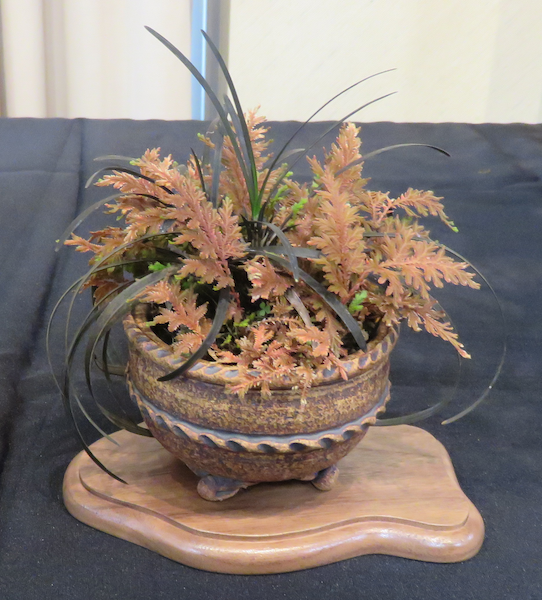 4.
4. 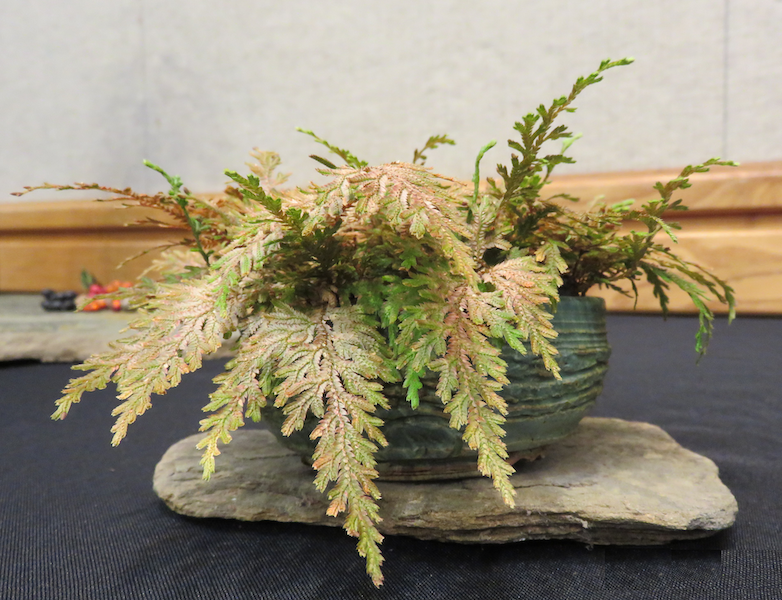 5.
5. 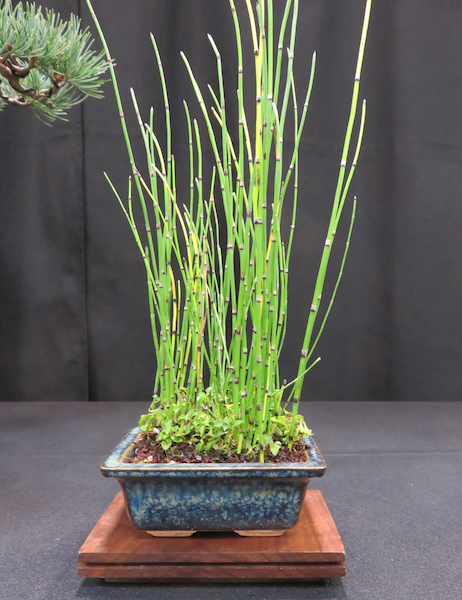
Examples of accents. 1. Flowering sedum. 2. Low-growing grass-like foliage. 3, 4. Selaginella. 5. Dwarf horsetail. Original photos by Dan Johnson.
Unlike bonsai trees, young accent plants often start out in their final show pots, particularly if they resent transplanting. They are groomed as carefully as trees, and may need several months or years in a pot before they are ready to show.
60.4 Options for Accents
There are innumerable options for accent plants. All of these species make good accent plants, and are seen regularly at exhibits.
- Dwarf caladiums
- Miniature begonias and geraniums
- Peacock mosses (Selaginella sp.)
- Dwarf mondo grass (Ophiopogon sp.)
- Dwarf clumping bamboos
- Carex sp. and other reed and sedge grasses
- Dwarf hostas
- Astilbes
- Dwarf ferns
The species listed below are less commonly used but are well suited for accent plants. The descriptions are a compilation of information from the pot tags, my personal observations, and data from USDAʼs horticultural database.
60.4.1 Accents for Xeric Trees
These accents are best paired with pines and other species found in arid and alpine areas.
60.4.1.1 Alpine geranium (Erodium reichardii)

Alpine geranium (Erodium reichardii). Link to original image.
A tender perennial originating from Corsica. These tiny, mounding cousins of garden geraniums have a very narrow hardiness range, from 7–9. They adapt well to life in pots, and can be brought under shelter for winter. The plants form tidy rosettes of heart–shaped fuzzy leaves 2-3 inches high by 4 inches wide. White to pink flowers appear in late spring or early summer; mine starting blooming Jun 1st. Alpine geraniums like neutral, well-draining and gritty soil. In the ground they can tolerate full sun, but potted plants do best with afternoon shade. Crowns are divided in late spring.
60.4.1.2 Redleaf thrift (Armeria maritima ʻRubrifoliaʼ)

Redleaf thrift (Armeria maritima ʻRubrifoliaʼ) Link to original image.
Shiny green hair–like foliage resembles a clump of ornamental grass. Leaves tinge reddish purple in spring and stay green all year. Crowns grow only 3 inches tall; 8–10-inch tall stalks with pom-poms of cerise pink flowers appear in late spring. It prefers afternoon shade in hot areas like ours, and burns in full sun. Do not cut plants back; pull out damaged leaves individually. Feed with liquid fertilizer spring and autumn. It is easy to propagate by dividing clumps. Protect from hard freezes.
60.4.1.3 Hen & Chicks (Sempervivum sp.)

Hen & Chicks (Sempervivum sp.) Link to original image.
Bigger cultivars of these succulents are common in gardens. In little pots they tend to stay small, and there are dwarf cultivars available that only grow 1-3 inches tall, tolerate full sun or partial shade, bloom all summer, and look best when they are crowded in the pot.
60.4.2 Accents for Mesic Trees
These accents are best paired with maples, oaks, elms, and other species found in areas with average moisture.
60.4.2.1 Crown of Thorns (Euphorbia milii)

Crown of Thorns (Euphorbia milii). Link to original image.
Smaller immature plants can be used as accents. The rough and ruggedly spiny stems are offset by bright red bracts and green leaves on the tips of stems. They grow best in free-draining soil similar to that for pines, but like to be watered and fertilized like a ficus.
60.4.2.2 Dwarf iris (Iris reticulata, Iris cristata)
Dwarf irises. Image 1. Iris reticulata. Image 2. Iris cristata. Link to original image 1; image 2.
This naturalized species resembles garden iris, but the leaves are only 5-6 inches tall; the flowers only add another 2 inches. The chief disadvantage as an accent plant is that they die back a month after flowering. Bulb vendors sell several colors for fall planting. Naturalized clumps can be very dense. Plant the bulbs barely beneath the surface of organic-rich soil in moisture-retaining soil, and grow in partial shade. They will bloom in spring, then quickly multiply and spread.
Like many bulbs, dwarf iris bulbs can be refrigerated for an extended time, then forced to bloom later in the year. Directions are available from www.whiteflowerfarm.com/forcinghardybulbs.html.
60.4.2.3 Yarrows (Achillea sp.)

Yarrow (Achillea millefolium)._ Link to original image.
All yarrows bear tiny flowers over finely cut foliage. They require full sun (6+ hours), and ordinary well drained garden soil. There are many cultivars on the market that are too tall for accents, but ʻKing Edwardʼ (Achilllea x lewisii) tops out at 3–6 inches. An added benefit to having yarrow around is it attracts lacewings and other beneficial insects that eat scale and aphids.
60.4.2.5 Miniature Begonia (Begonia sp.).

_Miniature Begonia (_Begonia sp.) Link to original image.
Rhizomatous and dwarf ‘Rex’ cultivars can be grown out until the stems become woody. After cutting back and thinning the stems, a flush of fresh new leaves will appear, each the size of a quarter.
60.4.3 Accents for Hydric Trees
These accents are best paired with cypresses, gums, ficus, and other species found in very moist to wet soil.
60.4.3.1 Sweet flag (Acorus gramineus ʻAureusʼ)

Sweet flag (Acorus gramineus). Link to original image.
Sweet flag forms tight clumps of chartreuse ribbon–like leaves up to 6 inches long. It loves water, and can be planted directly in shallow ponds (or wet spots beneath benches, but seems equally happy in drier soil. It does NOT tolerate sun in a small pot, and sulks when it is divided or cut back in spring. Once it gets going though, it seems to thrive on neglect.
60.4.3.2 Corkscrew Rush (Juncus effusus ‘Spiralis’)

Corkscrew Rush (Juncus effusus ‘Spiralis’). Link to original image.
This plant likes VERY wet feet.
60.4.3.3 Dwarf Horsetail (Equisetum scirpoides)
Dwarf Horsetail (Equisetum scirpoides). Link to original image.
The dwarf form reaches a maximum of 8 inches tall. Horsetail rushes like to be very wet. Keep confined to a pot, as it is invasive.
60.4.3.4 Purple Pitcher Plant (Sarracenia purpurea)
Purple Pitcher Plant (Sarracenia purpurea). Link to original image.
A small, tight clump of immaculately pruned pitchers in a glazed dish makes an attractive accent for cypresses. These native carnivorous plants live in nitrogen-poor sphagnum peat bogs. They need ample moisture.
60.4.3.5 Dwarf Papyrus Reed (Cyperus prolifer)

Dwarf papyrus reed (Cyperus prolifer). Link to original image.
Unlike its giant cousin, the dwarf form only grows 18 inches tall. Grow it in shallow standing water.
60.4.4 Other Non-Traditional Options
- Wild grasses or perennials can be collected locally with the permission of the landowner
- Seedlings of large-leaved plants or even some trees
- Dwarf herbs: creeping thyme, germander, santolina
- Dwarf grasses: ceeping red fescue, chewing fescus, dwarf rye
